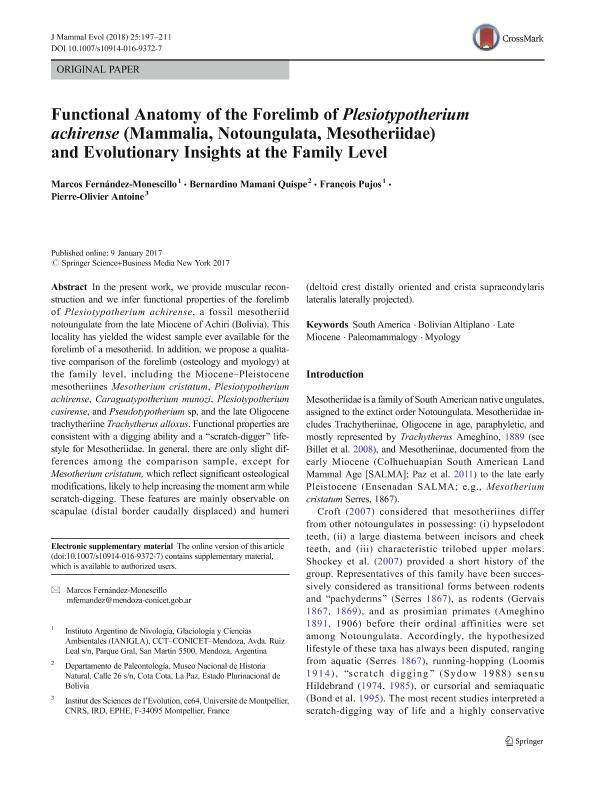Artículo
Functional Anatomy of the Forelimb of Plesiotypotherium achirense (Mammalia, Notoungulata, Mesotheriidae) and Evolutionary Insights at the Family Level
Fernández Monescillo, Marcos; Mamani Quispe, B.; Pujos, François Roger Francis ; Antoine, Pierre Olivier
; Antoine, Pierre Olivier
 ; Antoine, Pierre Olivier
; Antoine, Pierre Olivier
Fecha de publicación:
06/2018
Editorial:
Springer
Revista:
Journal of Mammalian Evolution
ISSN:
1064-7554
e-ISSN:
1573-7055
Idioma:
Inglés
Tipo de recurso:
Artículo publicado
Clasificación temática:
Resumen
In the present work, we provide muscular reconstruction and we infer functional properties of the forelimb of Plesiotypotherium achirense, a fossil mesotheriid notoungulate from the late Miocene of Achiri (Bolivia). This locality has yielded the widest sample ever available for the forelimb of a mesotheriid. In addition, we propose a qualitative comparison of the forelimb (osteology and myology) at the family level, including the Miocene–Pleistocene mesotheriines Mesotherium cristatum, Plesiotypotherium achirense, Caraguatypotherium munozi, Plesiotypotherium casirense, and Pseudotypotherium sp, and the late Oligocene trachytheriine Trachytherus alloxus. Functional properties are consistent with a digging ability and a “scratch-digger” lifestyle for Mesotheriidae. In general, there are only slight differences among the comparison sample, except for Mesotherium cristatum, which reflect significant osteological modifications, likely to help increasing the moment arm while scratch-digging. These features are mainly observable on scapulae (distal border caudally displaced) and humeri (deltoid crest distally oriented and crista supracondylaris lateralis laterally projected).
Palabras clave:
BOLIVIAN ALTIPLANO
,
LATE MIOCENE
,
MYOLOGY
,
PALEOMAMMALOGY
,
SOUTH AMERICA
Archivos asociados
Licencia
Identificadores
Colecciones
Articulos(IANIGLA)
Articulos de INST. ARG. DE NIVOLOGIA, GLACIOLOGIA Y CS. AMBIENT
Articulos de INST. ARG. DE NIVOLOGIA, GLACIOLOGIA Y CS. AMBIENT
Citación
Fernández Monescillo, Marcos; Mamani Quispe, B.; Pujos, François Roger Francis; Antoine, Pierre Olivier; Functional Anatomy of the Forelimb of Plesiotypotherium achirense (Mammalia, Notoungulata, Mesotheriidae) and Evolutionary Insights at the Family Level; Springer; Journal of Mammalian Evolution; 25; 2; 6-2018; 197-211
Compartir
Altmétricas



